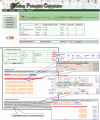CPC: assess the protein-coding potential of transcripts using sequence features and support vector machine - PubMed (original) (raw)
CPC: assess the protein-coding potential of transcripts using sequence features and support vector machine
Lei Kong et al. Nucleic Acids Res. 2007 Jul.
Abstract
Recent transcriptome studies have revealed that a large number of transcripts in mammals and other organisms do not encode proteins but function as noncoding RNAs (ncRNAs) instead. As millions of transcripts are generated by large-scale cDNA and EST sequencing projects every year, there is a need for automatic methods to distinguish protein-coding RNAs from noncoding RNAs accurately and quickly. We developed a support vector machine-based classifier, named Coding Potential Calculator (CPC), to assess the protein-coding potential of a transcript based on six biologically meaningful sequence features. Tenfold cross-validation on the training dataset and further testing on several large datasets showed that CPC can discriminate coding from noncoding transcripts with high accuracy. Furthermore, CPC also runs an order-of-magnitude faster than a previous state-of-the-art tool and has higher accuracy. We developed a user-friendly web-based interface of CPC at http://cpc.cbi.pku.edu.cn. In addition to predicting the coding potential of the input transcripts, the CPC web server also graphically displays detailed sequence features and additional annotations of the transcript that may facilitate users' further investigation.
Figures
Figure 1.
Screenshots of CPC output. (a) Results are summarized in a ‘Table View’. (b) Sequence features and additional annotations of an input transcript are shown in an Evidence page. Users can mouse over or click to see more details.
Similar articles
- Distinguishing protein-coding from non-coding RNAs through support vector machines.
Liu J, Gough J, Rost B. Liu J, et al. PLoS Genet. 2006 Apr;2(4):e29. doi: 10.1371/journal.pgen.0020029. Epub 2006 Apr 28. PLoS Genet. 2006. PMID: 16683024 Free PMC article. - PLEK: a tool for predicting long non-coding RNAs and messenger RNAs based on an improved k-mer scheme.
Li A, Zhang J, Zhou Z. Li A, et al. BMC Bioinformatics. 2014 Sep 19;15(1):311. doi: 10.1186/1471-2105-15-311. BMC Bioinformatics. 2014. PMID: 25239089 Free PMC article. - Non-coding transcription characterization and annotation: a guide and web resource for non-coding RNA databases.
Paschoal AR, Maracaja-Coutinho V, Setubal JC, Simões ZL, Verjovski-Almeida S, Durham AM. Paschoal AR, et al. RNA Biol. 2012 Mar;9(3):274-82. doi: 10.4161/rna.19352. Epub 2012 Mar 1. RNA Biol. 2012. PMID: 22336709 Review. - A Support Vector Machine based method to distinguish long non-coding RNAs from protein coding transcripts.
Schneider HW, Raiol T, Brigido MM, Walter MEMT, Stadler PF. Schneider HW, et al. BMC Genomics. 2017 Oct 18;18(1):804. doi: 10.1186/s12864-017-4178-4. BMC Genomics. 2017. PMID: 29047334 Free PMC article. - Differentiating protein-coding and noncoding RNA: challenges and ambiguities.
Dinger ME, Pang KC, Mercer TR, Mattick JS. Dinger ME, et al. PLoS Comput Biol. 2008 Nov;4(11):e1000176. doi: 10.1371/journal.pcbi.1000176. Epub 2008 Nov 28. PLoS Comput Biol. 2008. PMID: 19043537 Free PMC article. Review.
Cited by
- Integrated analysis of muscle lncRNA and mRNA of Chinese indigenous breed Ningxiang pig in four developmental stages.
Chen W, Yang F, Liufu S, Li Z, Gong Y, Ma H. Chen W, et al. Front Vet Sci. 2024 Oct 21;11:1465389. doi: 10.3389/fvets.2024.1465389. eCollection 2024. Front Vet Sci. 2024. PMID: 39497745 Free PMC article. - An Antisense Long Non-Coding RNA, LncRsn, Is Involved in Sexual Reproduction and Full Virulence in Fusarium graminearum.
Fu Z, Chen Y, Cai G, Peng H, Wang X, Li P, Gu A, Li Y, Ma D. Fu Z, et al. J Fungi (Basel). 2024 Oct 3;10(10):692. doi: 10.3390/jof10100692. J Fungi (Basel). 2024. PMID: 39452644 Free PMC article. - LncRNA MSTRG.13,871/miR155-5p/Grip1 network involved in the post-cardiac arrest brain injury.
Li Y, Wu C, Wen X, Hu W, Diao M. Li Y, et al. Sci Rep. 2024 Oct 23;14(1):25108. doi: 10.1038/s41598-024-75875-3. Sci Rep. 2024. PMID: 39443577 Free PMC article. - Long non-coding RNA-encoded micropeptides: functions, mechanisms and implications.
Xiao Y, Ren Y, Hu W, Paliouras AR, Zhang W, Zhong L, Yang K, Su L, Wang P, Li Y, Ma M, Shi L. Xiao Y, et al. Cell Death Discov. 2024 Oct 23;10(1):450. doi: 10.1038/s41420-024-02175-0. Cell Death Discov. 2024. PMID: 39443468 Free PMC article. Review. - Comparative transcriptome analysis to identify the important mRNA and lncRNA associated with salinity tolerance in alfalfa.
Yang G, Li Z, Rong M, Yu R, Zhang Q, Wang G, Xu Z, Du X, Xu X. Yang G, et al. PeerJ. 2024 Oct 16;12:e18236. doi: 10.7717/peerj.18236. eCollection 2024. PeerJ. 2024. PMID: 39430557 Free PMC article.
References
- Eddy SR. Non-coding RNA genes and the modern RNA world. Nat. Rev. Genet. 2001;2:919–929. - PubMed
- Mattick JS. RNA regulation: a new genetics? Nat. Rev. Genet. 2004;5:316–323. - PubMed
- Mattick JS, Makunin IV. Non-coding RNA. Hum. Mol. Genet. 2006;15:R17–R29. - PubMed
- Hatzigeorgiou AG, Fiziev P, Reczko M. DIANA-EST: a statistical analysis. Bioinformatics. 2001;17:913–919. - PubMed
Publication types
MeSH terms
Substances
LinkOut - more resources
Full Text Sources
Other Literature Sources
Research Materials
